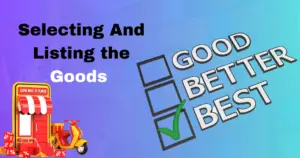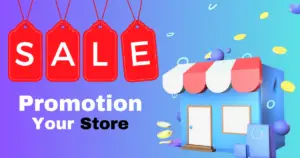It is quite obvious that many of those wanting to start an e-commerce business have already come across the drop-shipping business model. That is to be expected, as there seems to be a lot of strategic studies and business plans available online for people interested in starting and expanding a drop-shipping company. This is because it is a business model that requires minimal investment and allows effortless entry into the selling of devised businesses without ever having to manage the actual products and storage. The combination of expected returns with limited investment makes the method appealing not only to beginners but also to potential business owners who already possess high-level skills. This walkthrough covers all relevant aspects regarding the development and enhancement of the drop-shipping marketing model.
Thank you for reading this post, don't forget to subscribe!7 Steps To Get Started Drop Shipping Business

What is drop shipping?
The drop-shipping business model in e-commerce involves the selling of products by retailers but without carrying the merchandise as inventory. Suppliers who supply the product are the same people who will send the products ordered directly to the customers, and because of this, retailers will not have to concentrate on stocks but on expansion and marketing.
What Is the Process of Drop Shipping?
The customer makes a purchase from your site.
The site owner sends the requests to the supplier.
The manufacturer or supplier delivers the product to the buyer.
A business owner is able to reward himself by controlling the price of the auction and reselling above cost.
Primary Stakeholders in Drop shipping
Suppliers: The heart of your business that makes sure that the products you sell are of high quality and get shipped on time.
Retailers: You, who bears responsibility for the management of the storefront, interaction with customers, and advertisement.
Customers: Final recipients of the goods or consumers who actually use these goods that you sell.
III. Opening A Drop shipping Business

A. Choosing Your Niche
Success is dependent on strategizing a perfect business model, although there is a step that is fundamental in determining most of the aspects of your business, your niche.
Identify Profitable Niches: Research prosperous product areas by employing Google Trends, Ahrefs, and niche-relevant subreddits.
Analyzing the Competition and Their Market Strategies: Study their solid points and hedges. Other areas with high potential demand but low competitive levels should be preferred.
B. Looking for Good Suppliers
Only suitable suppliers can be relied on to match customer expectations and guarantee that the product gets delivered in good condition.
Know Your Suppliers: Check their ratings, history and the way their clients are treated.
Use Platforms: You may choose to use AliExpress, Alibaba or dropshipping platforms like CJ Dropshipping or Spocket to help simplify your operations.
C. Creating Your Online Store
Potential customers feel assured once they see that you have designed a proper storefront that is not hard to navigate.
Select the Right E-commerce Platform: Shopify offers appealing features such as ease of use and the ability to integrate with many outlets. WooCommerce is suitable for those who are familiar with platforms like WordPress, as it provides more opportunities for customisation.
Focus on User Experience (UX) in the design: The optimal design includes quick page loading times, an intuitive page structure, and is compatible with mobile devices.
IV. Selecting and listing the goods
How to Choose the Right Goods with High Demand
Focus on achieving a good product demand level with an acceptable profit margin and appealing appearance.
Research with Tools: leverage websites like Jungle Scout and SaleHoo to discover hot and niche products.
Market Testing: Actually, sell a small number of units to gauge the customer’s response before scaling up the offerings.
Tips on How to Write the Impressive Product Listing.
High-Quality Images: Provide clear pictures with a variety of views of the product. Supplement with lifestyle images as well.
Informative Product Descriptions: Write descriptive product pages that provide the information while persuading a customer to purchase. Add strong points, qualities, and how a particular product should be utilised.
SEO Best Practices: Use appropriate keywords for images and place relevant content about the site in the ovation.
V. Promotion of your drop-shipping store

A. Applying Social Media Marketing
Using social networks, you can grow your brand and reach potential customers.
Get Those Ads Targeted: You can use Facebook and Instagram for advertising and access targeted audiences with similar interests.
Influencer Marketing: Use micro-influencers already popular within a niche to build trust and increase reach.
B. Search Engine Optimization (SEO)
If your site is optimized correctly, it can rank highly on search results, acquire free traffic, and cut down on ad spending.
On-Site Optimisation: The title, description, and URLs of the product listing should be optimized.
Generate Traffic: A blog can be used to generate relevant content on your products, which can help to improve authority and organically traffic the site.
C. Email Marketing
Creating and maintaining an email list is critical for future customer retention.
Lead Magnets: Provide a favourable offer such as a discount or inform signing up users will receive a free guide for those who do sign up.
Engagement Strategies: Following up in a personalized way and offering additional products or exclusive offers will entice customers to purchase again.
VI. Order Management and Customer Service
How to Manage Orders More Effectively
Using apps like Oberlo or DSers that integrate with your chosen shop can help automate your order processes.
Synchronization with Stock: Regular interactions to update stock-out situations and the like.
How to Deliver Exceptional Service
Good experiences lead to repeat purchases from a shop with good reviews and referrals from customers.
Answering Questions Within 24 Hours: Assure customers by employing chatbots or AI for instant communication.
Simple Procedures for Returning Products: Provide customers with clear information about refund and return procedures to ensure understanding.
How to Ensure Strong Relationships With Customers
Feedback: Customers are requested to give feedback in the form of reviews, and feedback is generated by the customers.
Sending a Personalized Follow-up: Thank-you letters or loyalty rewards can be sent.
VII. Scaling Your Drop shipping Business
When and How to Expand Your Product Range
Gradually add other products related to your business and design with your customers in mind.
Upsell and cross-sell techniques: Offer related products in a bundle or try to add a more expensive product during checkout.
Automating Processes
Use tools such as AutoDS and Spocket to help you automate order management, upload inventory, and adjust prices.
Advanced Analytics Tools: Employ tools such as Google Analytics and Hotjar to monitor user interactions and enhance website performance.
Analyzing Performance Metrics
Look at different KPIs, including the conversion rate, the proportion of abandoned carts, and customer acquisition costs, among others. Review these metrics from time to time in order to modify your tactics.
VIII. Common Challenges and Solutions
Supply Chain Issues
Do not rely solely on one supplier; instead, have alternative suppliers.In the case of times in transit, utilise tracking orders to monitor the shipment as well.
Proactive Communication: Inform customers of the possibility of shipments taking longer than anticipated.
Managing Shipping Times
Include ePacket shipping methods to allow for faster shipping and other alternatives. Provide delivery times accurately through a message on the checkout page.
Handling Refunds and Negative Reviews
Always address customer issues with direct communication and offer quick remedies to meet the customer’s needs. Negative feedback should be responded to publicly so customers see a dedication to providing worthwhile services.
IX. Tips for Long-Term Success
Proactive Approach to Market Developments: Regularly go out to the market and check on new arrivals.
Website Optimization: Consistently work on speed and UX.
Build Brand Trust: Post videos and photos of actual clients with their reviews on your website.
X. Conclusion
Launching drop shipping is a smooth process that involves planning, the ability to remain flexible, and a focus on the needs of the customer. The methodologies outlined in the guide are self-sustainable and provide opportunities to develop revenues and expand progressively. Just continue learning more, innovating further, and refining your techniques to rank yourself higher than the contestants.
FAQs
1. Is it worth continuing with drop shipping in the year 2024?
As drop shipping still shows signs of viability, it is important to focus on a particular segment, work on marketing strategies, and have good suppliers for the business. The vital components are finding the right niche, having good marketing, and maintaining good relationships with suppliers. The amount of online retail trade continues to grow, providing diverse opportunities.
2. What is the minimum amount to start drop shipping?
Although these amounts may start at £100 to £500, varying amounts are incurred according to store creation, marketing, and product selection. If you have a larger budget, there is more room for ad testing and scaling.
3. Should I register my drop-shipping company?
Yes, it is important to register the business, and it helps with taxation as well as establishing a good impression. Support your responses by checking local laws to determine the specific requirements for this in your area.
4. Which are the most popular and appropriate platforms for drop shipping?
Due to their simplicity, a wide range of plugins, and the ability to connect with drop-shipping tools, Shopify, WooCommerce, and BigCommerce remain the most appropriate choices.
5. What are the procedures for refunds and returns in drop shipping?
Before starting, set return expectations with your supplier. Inform customers of the return policy as stated on the website to avoid discrepancies.
6. What strategies can smaller stores use to stand a chance against more prominent competitors?
Emphasise substandard products, vital customer service, and a powerful brand compared to what your larger rivals offer.
